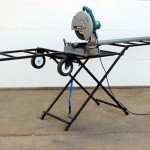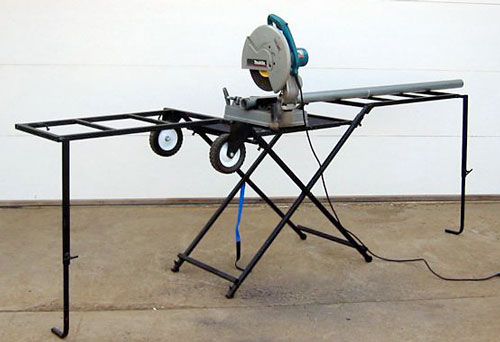When I first spotted the Power Bench delivery my heart sank, the shippers did a fine job of tearing the cardboard carton up and I had visions of returns in my head. Upon looking into the remnants of the box it appeared the contents had remained intact, so I decided I would open it up and have a look before I proceeded with the return process. When I opened the box, I was greeted with a very stout piece of equipment and it is my opinion that it would have taken a lot more than a torn carton to have damaged this bench, maybe backing the truck over it a time or two.
Included in the box along with Lee Unlimited Power bench are an instruction sheet and a small padded envelope containing a DVD and a small selection of sales literature. The wheels will have to be attached before use, that being only assembly required. There is a small learning curve you will have to master before you can use the Power Bench as it is not entirely intuitive in how it is set up, this should not take anyone more than a moment to become familiar with its operation, even less should you actually choose to read the instructions or view the DVD first.
My first impression of the Power Bench was how stoutly it has been built, while most manufacturers use the thinnest walled tubing they can get away with, Lee Unlimited has instead opted to use 11 gauge 1 inch square tubing for the main supports. While this does contribute to the weight of the Power Bench, I would rather deal with a little extra weight than have to deal with a flimsy or broken tool. I have to take a moment to mention the quality of the welds on the Power Bench, they are superb, with not a hint of gaps, splatters or erosion, which is rather rare to see in these days of mass production. The wheels included with the Power Bench have steel hubs that run on ball bearings which make for easy portability and will likely last a lot longer than the plastic wheels with bushings offered on a lot of their competitors stands. One interesting design feature that brought a smile to my face was the bit of Yankee ingenuity in using bent spikes as their spring loaded locking pins, they really add personal, home grown feel to the bench.
Overall the basic Power Bench is approximately 9 feet long, it does grow or shrink in length by a few inches, as the work table is raised or lowered and is 24 inches wide at its base, the widest point. There are optional extensions available to extend the working length of the bench should your work need it. The center table, where you should mount your saw is 28 inches long by 17 inches wide and the wings have a work space is 36 inches long by 18 inches wide. The Power Bench can be erected in any of six different heights ranging from 30 up to 41 inches. I’m on the taller side so I really appreciate the ability to adjust the work height. The height adjustment is made by extending the middle table allowing the center section to rise or settle into a taller or lower stance. The center table sits 3 inches lower than the side tables which my Makita 1214 sliding compound miter saw table sits proud of by approximately half an inch. The only provisions for adjustment listed in the manual is the use of shims, which in my case was half inch plywood applied to the side tables. An undocumented feature is the ability to adjust the table height by means of the sliding sleeves built into the center tables mounts, which are locked in place by both a Tek screw and a bolt. The center table has an expanded metal mesh as its main work surface which makes mounting any saw to it a breeze, with the added benefit that it does not provide a surface for any sawdust to accumulate.
 The Power Bench takes only a few moments to set up once you become familiar with it’s operation. Once it is set up, it is very sturdy with no wobbles or shakes at all whether it is set up on smooth pavement or rough ground. A word of warning here, this stand has unprotected metal feet, if it is set up on a finished floor without protection it will most likely leave marks. I found that this stand is much more at home doing rough carpentry than it is doing trim work. The lack of fence being the major shortcoming in working with trim. This lack of fence is also what makes this stand ideal for rougher work. When you cutting 2 x material at a fast pace it is very easy to load and unload the bench. It is at this point I’ll admit that my favorite use for this stand doesn’t include a miter saw at all. I really like using this bench as a cut station for use with a regular circular saw. It is much better than a set of saw horses as both ends of your work
The Power Bench takes only a few moments to set up once you become familiar with it’s operation. Once it is set up, it is very sturdy with no wobbles or shakes at all whether it is set up on smooth pavement or rough ground. A word of warning here, this stand has unprotected metal feet, if it is set up on a finished floor without protection it will most likely leave marks. I found that this stand is much more at home doing rough carpentry than it is doing trim work. The lack of fence being the major shortcoming in working with trim. This lack of fence is also what makes this stand ideal for rougher work. When you cutting 2 x material at a fast pace it is very easy to load and unload the bench. It is at this point I’ll admit that my favorite use for this stand doesn’t include a miter saw at all. I really like using this bench as a cut station for use with a regular circular saw. It is much better than a set of saw horses as both ends of your work
are supported and you still have the center section open for blade clearance. Even plywood is well supported and easy to cut on this stand. Cutting mortises and tenons in larger timbers was especially easy for me due to the stands adjustable height as I didn’t have to spend half my day either hunched over or stretching out to make the repetitive cuts required for this work.
Overall I would say that the Power Bench is a winner, versatile, durable, well constructed and easy to use and best of all, assembled right here in the good old U.S.A. To learn more about Power Bench, you can visit their website.


